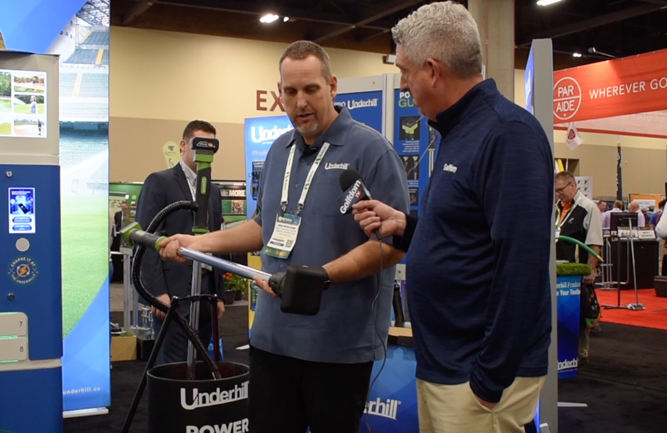Erin Hills earns respect
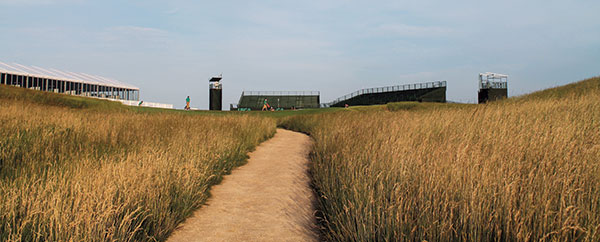
The first U.S. Open in Wisconsin braves severe weather and extreme heat to provide the ultimate test of golf.
There wasn’t much drama on Sunday at Erin Hills when it came to who would hoist the 2017 U.S. Open trophy. Brooks Koepka overpowered the course and went birdie-birdie-birdie on holes 14, 15 and 16 to leave the field gasping and grab the tournament by the throat.
But the first U.S. Open to be played in the state of Wisconsin did have some drama when it came to the golf course itself. Wild weather, an angry Tour pro and mid-week adjustments kept the course, its conditions and its crew in the spotlight right up until the players teed off on Thursday.
Despite the drama, the course and its crew came through impeccably, earning rave reviews from both players and pundits. The 2017 U.S. Open at Erin Hills in Erin, Wis., will be a tournament long remembered by the crew, the players and the 26.5 million television viewers who tuned in around the world.
Na problem

Though he missed the cut, Rory McIlroy was quick to defend the tall fescue at Erin Hills, saying if players couldn’t handle it they should “go home.”
The tall fescue rough at Erin Hills was talked about early and often, both by talking heads on TV, then the players. Most notable was PGA Tour player Kevin Na, who posted a video on Instagram blasting the tall rough as “almost unplayable.” The video was viewed more than 70,000 times and created a mild uproar from golfers and golf fans.
On Monday night, high winds and heavy rain blew through the course, knocking down areas of the rough. Upon orders of USGA CEO Mike Davis, and under the direction of USGA Director of Championship Agronomy Darin Bevard, two areas of rough (on No. 4 and No. 14) quickly were mowed down by a crew of two dozen Erin Hills maintenance workers. Cameras ascended on the work and conclusions were jumped to. Many accused the USGA of overreacting to Na’s comments.
But the USGA stood firm in its pronouncement that the mowing was done in order to fix damaged areas, not because of any golfer’s Instagram video.
“It’s for playability. We’re cutting down areas that were knocked down by the rain,” Bevard told Golfdom. “It would be completely unplayable — that’s not our goal.”

Jim Furyk gives a few pointers to his son, Tanner Furyk, during a practice round.
In the weeks following the U.S. Open, Bevard reflected on the rough being mowed, and noted it was something that Erin Hills Superintendent Zach Reineking predicted would need to happen.
“I’ll be honest, I don’t think there were any curve balls (at the 2017 U.S. Open),” Bevard said. “Even the little bit of cutting the fescue when it was all matted and laid down — Zach predicted that would happen. We were prepared to evaluate it on Tuesday morning, react and do what we needed to do.”
Bevard went on to heap praise upon Reineking and his crew at Erin Hills.
“Strictly for course set-up, I’d give them an A+,” Bevard said when asked how he’d grade the crew. “The one thing I told Zach, organizationally, he and his team were as good as any team we’ve worked with. In terms of sequencing and getting guys going in the morning, they really had things dialed in and organized, which makes our jobs easy. My parting thought to them was simply, ‘Thank you,’ because they made us look good on the USGA side, when things go that smoothly on a daily basis.”
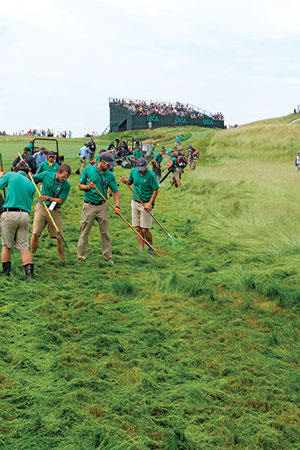
An area of tall rough on No. 14 gets a quick clip.
Bevard had only one complaint, and it concerned the one thing no one can control: the weather. He wished it would have been drier and windier. He laughed, and said that everywhere he went, he seemed to have a target on his back for bad weather — it was pouring rain on him at the U.S. Women’s Open at Trump National Bedminster as he was speaking.
“If the weather is hit-or-miss, it seems I’m going to get hit,” he says. “Eventually, I’ll get missed. But conditions were lauded all week, both by players and even media types. In terms of conditioning — where my focus is — (Erin Hills) was about as good as it could be.”
Best. Surface. Ever.
It seemed the greens at Erin Hills universally were adored by the players. Obviously, Koepka enjoyed them, but so did Justin Thomas, who shot a blistering 63 on Saturday, breaking Johnny Miller’s 44-year-old record of lowest round in relation to par in a major (Miller went 8-under in the ’73 U.S. Open, posting a 63, while Thomas went 9-under, also posting a 63.)
Golfdom interviewed eight players at the U.S. Open (including Thomas, who described Erin Hills as “just pure”), and all of them raved about the course, especially the greens.
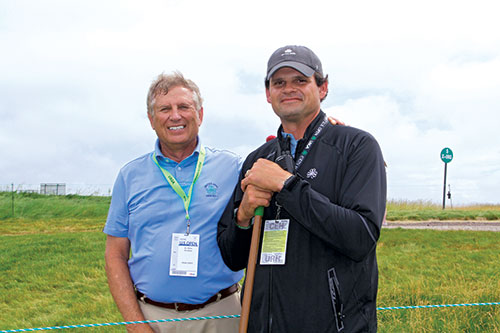
Erin Hills’ Architect Dr. Michael Hurdzan (left) and Zach Reineking.
“The greens are as good as any you’ll ever see, and the rest of it is in good shape too,” said Martin Laird. Tommy Fleetwood said, “The greens are great… overall they have been very true. I walked onto the putting green on Sunday and it was pretty much the best surface I had ever seen.” And Jim Furyk, after calling us liars (see footnote) said, “Course conditions are phenomenal. I couldn’t imagine it being any better.”
Reineking said it was both humbling and surreal to have the best players in the world rave so much about the greens.
“I think superintendents in general are critical of their own facilities,” Reineking said. “We’ve had the fortunate experience of attending the last couple U.S. Opens. We went to Oakmont. Oakmont is meticulous! Every blade of grass is exactly where it’s supposed to be. To hear comments from players like that, who just the year prior played Oakmont? It is a surreal thing.”
Reineking said there was talk in the maintenance building before the tournament about what the winning score might be. The one thing everyone agreed on was that someone might go low based on the trueness of the greens.
“One of the great traits of Erin Hills is that the greens roll really pure,” Reineking said. “We knew if someone was hot on their putter, scores would be low because these guys are so good. There was a stat that came out on Saturday, that the top 60 players didn’t miss a single putt from within 5 feet of the hole. That shows one, the quality of golfers playing in the U.S. Open, and two, the purity of our greens that they roll so true that if you’re on-line, it’s going to roll in.”
Elation at the end
One benefit Erin Hills enjoyed in anticipation of the U.S. Open was that it was closed for months before the tournament, allowing staff to build up the course without the burden of daily play. The course was in excellent condition when it was time for the 2017 U.S. Open to commence.
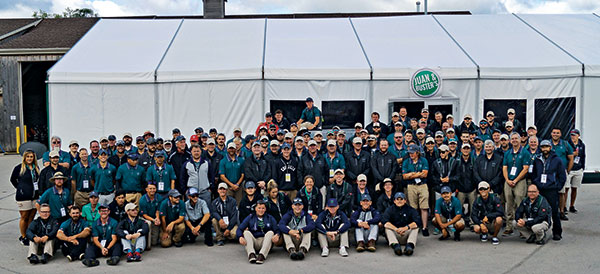
Despite extreme heat and heavy storms, the maintenance crew at Erin Hills was up to the task of hosting Wisconsin’s first U.S. Open.
Reineking said the biggest challenge he and his crew faced was the atypical weather.
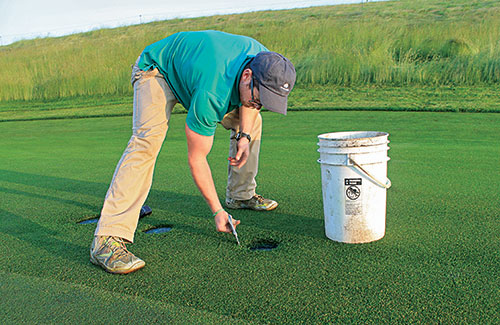
Erin Hills didn’t earn such high praise without some detailed work. This maintenance crew member uses scissors to trim turf around a sprinkler head.
“The combination of a cool/wet spring, then a heat wave where we came close to record temperatures, plus the rain,” Reineking noted. “You can plan for two of those, but to get all three, that’s hard to predict.”
Reineking said that the crew was thanked by both the owner of the course and the general manager in a ceremony near the 18th green just after the tournament ended.
“It was a new venue for a U.S. Open, there was a lot of questioning of if the course was capable of hosting the U.S. Open,” Reineking told Golfdom. “Getting to that day and knowing the feedback of the players and the media — who can be pretty critical of the USGA and the U.S. Open — it all came back positive. We put so much time and effort into the tournament. To be in that moment and let it all sink in… it was just elation.
Photos by: Grant B. Gannon, Seth Jones









